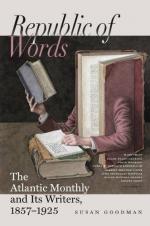“Peculiar” derives its title from one of the characters of the novel, an escaped negro slave, who has received from his sportive master the name of “Peculiar Institution.” The great dramatic fact of the story lies in the kidnapping of the infant child of wealthy Northern parents who have been killed in a steamboat-explosion on the Mississippi. The child, a girl, is saved from the water, but saved by two “mean whites,” creatures and hangers-on of the Slave Power, who take her to New Orleans, and finally, being in want of money, sell her with other slaves at auction. In a very graphic and truthful scene, the “vendue” is depicted. About this little girl, Clara by name, the intensest interest is thenceforth made to centre. Her every movement is artfully made a matter of moment to the reader.
Antecedent to the introduction of Clara, the true heroine of the novel, we have the story of Estelle, also a white slave. At first this story seems like an episode, but it is soon found to be inextricably interwoven with the plot. The author has shown remarkable dexterity in preserving the unity of the action so impressively, while dealing with such a variety of characters. Like a floating melody or tema in a symphony or an opera, the souvenirs of Estelle are introduced almost with the effect of pathetic music. Indeed, to those accustomed to look at plots as works of art, the constructive skill manifest in this novel will be not the least of its attractive features.
One word as to the characters. These are drawn with a firm, confident pencil, as if they were portraits from life. Occasionally, from very superabundance of material, the author leaves his outline unfilled. But the important characters are all live and actual flesh and blood. In Pompilard, a capitally drawn figure, many New-Yorkers will recognize an original, faithfully limned. In Colonel Delancy Hyde, “Virginia-born,” we have a most amusing representative of the lower orders of the “Chivalry.” Estelle is a charming creation, and we know of few such touching love-stories as that through which she moves with such naturalness and grace. In the cousins Vance and Kenrick we have strongly marked and delicately discriminated portraits. The negro “Peculiar” is made to attract much of our sympathy and respect. He is not the buffoon that the stage and the novel generally make of the black man. He belongs rather to the class of which Frederick Douglas is a type. It is no more than poetic justice that from “Peculiar” the book should take its name.
We should say more of the plot, did we not purposely abstain from marring the reader’s interest by any indiscreet foreshadowing. Everybody seems to be reading or intending to read the book; and its success is already so far assured that no hostile criticism can gainsay or check it. Not the least of the merits of “Peculiar” is the healthy patriotic spirit which runs through it, vivifying and intensifying the whole. The style is remarkably animated, often eloquent, and would of itself impart interest to a story far less rich than this in incident, and less powerful in plot.




